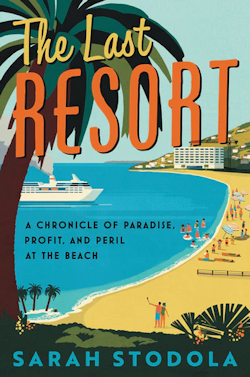SEJournal Online is the digital news magazine of the Society of Environmental Journalists. Learn more about SEJournal Online, including submission, subscription and advertising information.
BookShelf: The Seven Stages of Beach Exploitation (and Restoration)
“The Last Resort: A Chronicle of Paradise, Profit, and Peril at the Beach”
By Sarah Stodola
HarperCollins, $27.99
Reviewed by Jennifer Weeks
When you hear the phrase “relaxing getaway,” do you picture a beach lined with palm trees?
 |
That’s the image that the tourism industry has cultivated for the past century-plus. But beach tourism is far from paradise for many people who live around resort areas. Managed well, it can enrich local communities, but all too often it excludes them and drains their resources.
In “The Last Resort: A Chronicle of Paradise, Profit, and Peril at the Beach,” travel and culture writer Sarah Stodola beach-hops around the world to consider the past, present and future of coastal travel. Her itinerary doesn’t have a clear geographic or historical focus — she ranges from Fiji to Senegal, Long Island to Acapulco — and she pays a lot of attention to the generic food and drinks on offer at her various stops.
But whether you love the beach or feel weirdly ambivalent about tropical vacations, Stodola makes some interesting points about how seaside resorts affect the host areas. She quotes a 1980 analysis that proposed six or seven stages of growth for tourist areas and applies them to beach destinations. The seven-stage sequence goes like this:
- Exploration: Few visitors, no tourist facilities and interaction with local culture (shh, if you know a place like this, don’t say anything).
- Involvement: Locals start offering services and accommodations to tourists (example: Nias, Indonesia).
- Development: Chain hotels arrive, marketing kicks in and locals lose influence (example: San Juan del Sur, Nicaragua).
- Consolidation: Tourism becomes a major economic driver for the area (example: Tulum, Mexico).
- Stagnation: Tourism numbers peak, and problems such as crowding and pollution become impossible to ignore (example: Daytona Beach, Florida).
- Decline: Tourists start going to newer, hotter, less-spoiled places (example: Acapulco).
- Rejuvenation: Some regions pivot to new draws, ranging from museums to attracting industries like tech (example: British seaside resorts).
Stodola is good at describing contradictions. Pondering why many affluent travelers are willing to rough it in Tulum, the “boutiquey beachfront du jour,” she observes the following:
“Tulum has become a study in paradoxes, where ‘eco-resorts’ run on bungalow-sized diesel generators, their waste seeping through the delicate limestone ground into the vast underground river system that provides the Yucatan’s main source of freshwater. Where $500 a night does not guarantee you’ll have air conditioning in your room. … Where the special inclusive beautiful vibe that everyone talks about only seems to function properly for attractive people.”
She finds some interesting cross-currents on St. Kitt’s, one of the less-touristy Caribbean islands, which just started pursuing working tourism in the early 2000s after its sugar industry shut down. The island is working to limit its tourism to a manageable level.
The government is working to cultivate a limited number of high-end resorts instead of promoting mass development. Local residents have access to beaches and restaurants that also cater to tourists, and the island has barred all-inclusive resorts, which typically keep guests on their grounds all day instead of urging them to explore the area and patronize local businesses.
Rising seas, extreme weather an issue
Climate change is a serious threat to beach travel, and Stodola finds plenty of examples.
In Hawaii, sea level in relation to the shoreline has already risen two to six inches since 1960. Waikiki, Oahu’s world-famous beach, regularly experiences sunny-day flooding, and many of its hotels have already lost much or all of their beaches.
In Vietnam, increasingly intense typhoons are carving up beaches even as hotel development is in full swing.
Miami Beach has used most of its
offshore sand reserves for beach
engineering and may have to start
barging it over from the Bahamas.
Miami Beach has used most of its offshore sand reserves for beach engineering and may have to start barging it over from the Bahamas — if it can get permission from Congress to import it.
Looking to the future, Stodola offers a list of ideas for making beach tourism more sustainable and inclusive. Some, such as discouraging carbon-intensive long-haul air travel to get there, are out of destinations’ hands.
Others are more feasible, such as sourcing food and materials locally and regionally, and not building golf courses, which suck up huge quantities of water and are big nutrient pollution sources.
My favorite recommendation is to stop planting palm trees, which require a lot of water, don’t provide much shade and have shallow root systems that don’t hold sand in place very well.
West Palm Beach, Florida already is requiring more shade-producing trees in parking lots, and Los Angeles and San Diego are considering similar rules.
Maybe beach postcards of the future will feature banyan trees or live oaks.
SEJournal Contributing Editor Jennifer Weeks is senior environment and energy editor at The Conversation US and a former board member of the Society of Environmental Journalists.
* From the weekly news magazine SEJournal Online, Vol. 8, No. 24. Content from each new issue of SEJournal Online is available to the public via the SEJournal Online main page. Subscribe to the e-newsletter here. And see past issues of the SEJournal archived here.













 Advertisement
Advertisement 



